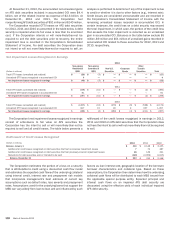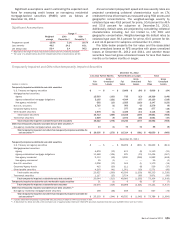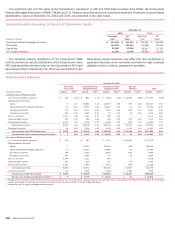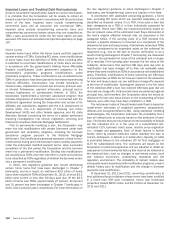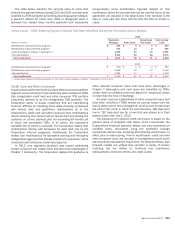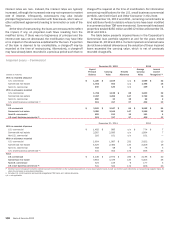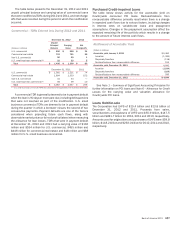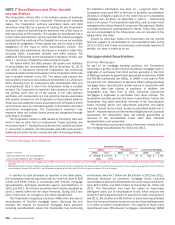Bank of America 2012 Annual Report Download - page 192
Download and view the complete annual report
Please find page 192 of the 2012 Bank of America annual report below. You can navigate through the pages in the report by either clicking on the pages listed below, or by using the keyword search tool below to find specific information within the annual report.190 Bank of America 2012
Impaired Loans and Troubled Debt Restructurings
A loan is considered impaired when, based on current information,
it is probable that the Corporation will be unable to collect all
amounts due from the borrower in accordance with the contractual
terms of the loan. Impaired loans include nonperforming
commercial loans and all consumer and commercial TDRs.
Impaired loans exclude nonperforming consumer loans and
nonperforming commercial leases unless they are classified as
TDRs. Loans accounted for under the fair value option are also
excluded. PCI loans are excluded and reported separately on page
197.
Home Loans
Impaired home loans within the Home Loans portfolio segment
consist entirely of TDRs. Excluding PCI loans, most modifications
of home loans meet the definition of TDRs when a binding offer
is extended to a borrower. Modifications of home loans are done
in accordance with the government’s Making Home Affordable
Program (modifications under government programs) or the
Corporation’s proprietary programs (modifications under
proprietary programs). These modifications are considered to be
TDRs if concessions have been granted to borrowers experiencing
financial difficulties. Concessions may include reductions in
interest rates, capitalization of past due amounts, principal and/
or interest forbearance, payment extensions, principal and/or
interest forgiveness, or combinations thereof. In 2012, the
Corporation implemented a borrower assistance program that
provides forgiveness of principal balances in connection with the
settlement agreement among the Corporation and certain of its
affiliates and subsidiaries, together with the U.S. Department of
Justice (DOJ), the U.S. Department of Housing and Urban
Development (HUD) and other federal agencies, and 49 state
Attorneys General concerning the terms of a global settlement
resolving investigations into certain origination, servicing and
foreclosure practices (National Mortgage Settlement).
Prior to permanently modifying a loan, the Corporation may
enter into trial modifications with certain borrowers under both
government and proprietary programs, including the borrower
assistance program pursuant to the National Mortgage
Settlement. Trial modifications generally represent a three- to four-
month period during which the borrower makes monthly payments
under the anticipated modified payment terms. Upon successful
completion of the trial period, the Corporation and the borrower
enter into a permanent modification. Binding trial modifications
are classified as TDRs when the trial offer is made and continue
to be classified as TDRs regardless of whether the borrower enters
into a permanent modification.
In 2012, new regulatory guidance was issued addressing
certain home loans that have been discharged in Chapter 7
bankruptcy, and as a result, an additional $3.5 billion of home
loans were included in TDRs at December 31, 2012, of which $1.2
billion were current or less than 60 days past due. Of the $3.5
billion of home loan TDRs, approximately 27 percent, 42 percent
and 31 percent had been discharged in Chapter 7 bankruptcy in
2012, 2011 and prior years, respectively. For more information on
the new regulatory guidance on loans discharged in Chapter 7
bankruptcy, see Nonperforming Loans and Leases in this Note.
In accordance with applicable accounting guidance, a home
loan, excluding PCI loans which are reported separately, is not
classified as impaired unless it is a TDR. Once such a loan has
been designated as a TDR, it is then individually assessed for
impairment. Home loan TDRs are measured primarily based on
the net present value of the estimated cash flows discounted at
the loan’s original effective interest rate, as discussed in the
paragraph below. If the carrying value of a TDR exceeds this
amount, a specific allowance is recorded as a component of the
allowance for loan and lease losses. Alternatively, home loan TDRs
that are considered to be dependent solely on the collateral for
repayment (e.g., due to the lack of income verification or as a
result of being discharged in Chapter 7 bankruptcy) are measured
based on the estimated fair value of the collateral and a charge-
off is recorded if the carrying value exceeds the fair value of the
collateral. Home loans that reached 180 days past due prior to
modification had been charged off to their net realizable value
before they were modified as TDRs in accordance with established
policy. Therefore, modifications of home loans that are 180 days
or more past due as TDRs do not have an impact on the allowance
for loan and lease losses nor are additional charge-offs required
at the time of modification. Subsequent declines in the fair value
of the collateral after a loan has reached 180 days past due are
recorded as charge-offs. Fully-insured loans are protected against
principal loss, and therefore, the Corporation does not record an
allowance for loan and lease losses on the outstanding principal
balance, even after they have been modified in a TDR.
The net present value of the estimated cash flows is based on
model-driven estimates of projected payments, prepayments,
defaults and loss-given-default (LGD). Using statistical modeling
methodologies, the Corporation estimates the probability that a
loan will default prior to maturity based on the attributes of each
loan. The factors that are most relevant to the probability of default
are the refreshed LTV, or in the case of a subordinated lien,
refreshed CLTV, borrower credit score, months since origination
(i.e., vintage) and geography. Each of these factors is further
broken down by present collection status (whether the loan is
current, delinquent, in default or in bankruptcy). Severity (or LGD)
is estimated based on the refreshed LTV for first mortgages or
CLTV for subordinated liens. The estimates are based on the
Corporation’s historical experience, but are adjusted to reflect an
assessment of environmental factors that may not be reflected in
the historical data, such as changes in real estate values, local
and national economies, underwriting standards and the
regulatory environment. The probability of default models also
incorporate recent experience with modification programs, a loan’s
default history prior to modification and the change in borrower
payments post-modification.
At December 31, 2012 and 2011, remaining commitments to
lend additional funds to debtors whose terms have been modified
in a home loan TDR were immaterial. Home loan foreclosed
properties totaled $650 million and $2.0 billion at December 31,
2012 and 2011.


